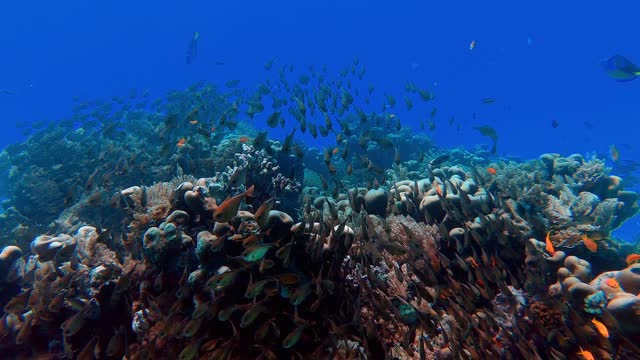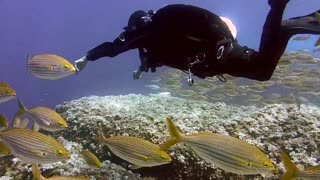Premium Only Content

School Of Fish In The Deep Blue Sea
The ocean’s aquamarines and seafoam greens are shifting as climate change warms the planet. A study published Monday in Nature Communications predicts that the colors of the world’s oceans will intensify by the end of this century as changes in phytoplankton patterns alter light reflection.
Water molecules absorb all visible light except for those at blue wavelengths, making the ocean appear blue. When phytoplankton float near the surface, they change how incoming light reflects. Typically, the greener the ocean water, the more phytoplankton occur there. Satellites can differentiate subtle changes in hues from hundreds of kilometers away.
Previous research has suggested that warming waters will alter phytoplankton distribution in the ocean, but pinpointing this trend in the data can be difficult because commonly used metrics fluctuate due to other factors like El Niño and La Niña. The latest study models ocean color using a metric that better resolves long-term trends.
The results reveal that the color of 50% of the ocean will change by 2100 due to the shuffling of phytoplankton communities. Blue regions in the subtropics will grow bluer as fewer phytoplankton are able to survive in its waters. Green regions at the poles will turn greener as warming waters become more habitable for them. The color change won’t be discernible to the human eye, the researchers write in the study, but satellites will be able to see an “unambiguous signal.”
Models that include light reflectance as well as the complex physical, biogeochemical, and ecological processes in the ocean are rare. This study is the first to consider the impact of climate change on ocean color.
-
 0:43
0:43
Rumble Time Now
3 years agodeep sea diving with a school of fish surrounding
431 -
 8:44
8:44
RTT: Guns & Gear
19 hours ago $1.92 earnedStreamlight TLR RM2 Laser - G | The Best PCC Light
25.7K -
 36:38
36:38
Athlete & Artist Show
1 month ago $2.46 earnedNCAA Hockey Was A Joke, TNT Hockey Panel Is The Best In Sports
20.2K1 -
 1:00:08
1:00:08
Trumpet Daily
22 hours ago $4.70 earnedBanning Mystery of the Ages - Trumpet Daily | Jan. 17, 2025
10.6K16 -
 15:10
15:10
Chris From The 740
1 day ago $0.78 earnedEAA Girsan Disruptor X 500-Round Review: Is It Reliable?
7.92K -
 1:00:38
1:00:38
PMG
17 hours ago $3.04 earnedCarnivore & Dr. Shawn Baker - Health Starts With Food
42.1K3 -
 1:28:13
1:28:13
Kim Iversen
18 hours agoCancelled Chef Pete Evans Exposes The One Change That Could End Big Food and Pharma
95.8K93 -
 4:20:21
4:20:21
Nerdrotic
19 hours ago $82.22 earnedDaradevil Born Again, Comics Industry CRASH, Neu-Hollywood REBUILD | Friday Night Tights #337
257K63 -
 1:32:34
1:32:34
Glenn Greenwald
15 hours agoThe Future of Gaza With Abubaker Abed; Journalist Sam Husseini On His Physical Expulsion From Blinken’s Briefing & Biden’s Gaza Legacy | System Update #391
131K100 -
 1:34:48
1:34:48
Roseanne Barr
18 hours ago $27.49 earnedWe are so F*cking Punk Rock! with Drea de Matteo | The Roseanne Barr Podcast #83
101K83